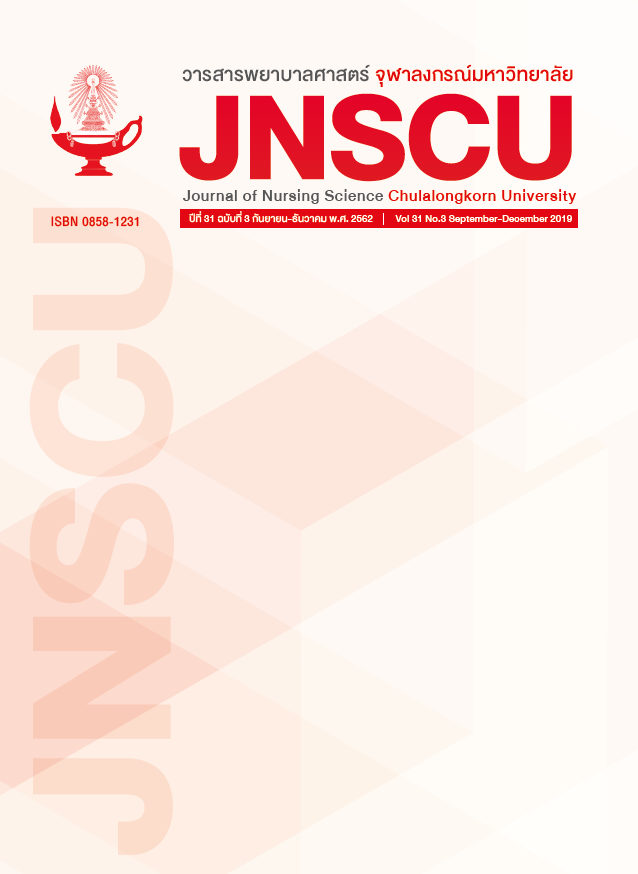การจัดการสุขภาพของกลุ่มเสี่ยงโรคเบาหวานในชุมชนบ้านม่วงหวาน : มุมมองจากการศึกษาเชิงคุณภาพ
คำสำคัญ:
การจัดการสุขภาพ, โรคเบาหวาน, การศึกษาเชิงคุณภาพบทคัดย่อ
วัตถุประสงค์: เพื่อศึกษาการจัดการสุขภาพของกลุ่มเสี่ยงโรคเบาหวานในชุมชน
แบบแผนการวิจัย: การวิจัยเชิงคุณภาพ
วิธีดำเนินการวิจัย: ผู้ให้ข้อมูลจำนวน 75 คน ประกอบด้วย ประชาชนกลุ่มเสี่ยงเป็นโรคเบาหวานและครอบครัว เจ้าหน้าที่โรงพยาบาลส่งเสริมสุขภาพตำบล นำชุมชน อาสาสมัครสาธารณสุขประจำหมู่บ้าน (อสม.) พระสงฆ์ ครู และแม่ค้าขายอาหารที่ชุมชนบ้านม่วงหวาน เครื่องมือวิจัยประกอบด้วย 1) แบบสัมภาษณ์เชิงลึก 2) แนวทางการสนทนากลุ่ม 3) แนวทางการประชุมระดมสมอง 4) แนวทางการสังเกต และ 5) แบบบันทึกภาคสนาม วิเคราะห์ข้อมูลด้วยการวิเคราะห์เชิงเนื้อหา
ผลการวิจัย: กลุ่มเสี่ยงโรคเบาหวานได้ดูแลสุขภาพตนเองโดยการควบคุมอาหารและน้ำหนักตัว ออกกำลังกาย จัดการความเครียด ลดการดื่มเครื่องดื่มที่มีแอลกอฮอล์ ลดการสูบบุหรี่และไปรับการตรวจคัดกรองโรคเบาหวานประจำปี ครอบครัวกลุ่มเสี่ยงได้แบ่งเบาภาระงาน ร่วมออกกำลังกาย กระตุ้นและกล่าวเตือนเมื่อกลุ่มเสี่ยงมีพฤติกรรมไม่เหมาะสม ชุมชนได้สนับสนุนการดูแลสุขภาพโดยให้ข้อเสนอแนะและข้อมูลด้านการดูแลสุขภาพ ปัญหาและอุปสรรคที่พบคือการให้บริการตรวจคัดกรองเบาหวานไม่ทั่วถึง ขาดสถานที่ ผู้นำ แรงจูงใจและความต่อเนื่องในการออกกำลังกาย
สรุป: การจัดการสุขภาพของกลุ่มเสี่ยงโรคเบาหวานในชุมชนเป็นความรับผิดชอบของกลุ่มเสี่ยงและครอบครัว เจ้าหน้าที่
รพสต. ให้บริการตรวจสุขภาพ ผู้นำชุมชนร่วมรับรู้ปัญหา สนับสนุนการแก้ปัญหาและเป็นแบบอย่างการดูแลสุขภาพ อสม. เฝ้าระวังและให้ข้อมูลการดูแลสุขภาพแก่กลุ่มเสี่ยง
เอกสารอ้างอิง
World Health Organization. Global report on diabetes. World Health Organization;2016.
International Diabetes Federation. IDF Diabetes Atlas, 8th ed. Brussels, Belgium: International Diabetes Federation; 2017.
American Diabetes Association. Classification and Diagnosis of Diabetes. Diabetes Care 2017; 40 (Suppl. 1): S11-S24; DOI: 10.2337/dc17-S005
Miot A, Ragot S, Hammi W, Saulnier PJ, Sosner P, Piguel X, et al. Prognostic value of resting heart rate on
cardiovascular and renal outcomes in type 2 diabetic patients: a competing risk analysis in a prospective cohort.
Diabetes Care 2012; 35(10): 2069–75; DOI: http://dx.doi.org/10.2337/dc11-2468.
Yau JW, Rogers SL, Kawasaki R, Lamoureux EL, Kowalski JW, Bek T, et al. Global prevalence and major risk factors of diabetic retinopathy. Diabetes care 2012; 35(3): 556-64.
Chronic Kidney Disease Prevention Project in Hypertension and Diabetes Patients 2559. Nonthaburi, Thailand: Department of Disease Control, Ministry of Public Health; 2016.
Lima VC, Cavalieri GC, Lima MC, Nazario NO, & Lima GC. Risk factors for diabetic retinopathy: a case-control study. International journal of retina and vitreous 2016; 2(1): 21-7; DOI 10.1186/ s40942-016-0047-6
Chatterjee S, Riewpaiboon A, Piyauthakit P, Riewpaiboon W, Boupaijit K, Panpuwong N, et al. Cost of diabetes and its complications in Thailand: a complete picture of economic burden. Health Soc Care Community 2011; 19(3): 289-98. (In Thai)
Thai National Health Examination Survey V Study Group. Thai National Health Examination Survey, NHES V.
Nonthaburi, Thailand: National Health Examination Survey Office, Health System Research Institute; 2016.
Zhang P, Zhang X, Brown J, Vistisen D, Sicree R, Shaw J, et al. Global healthcare expenditure on diabetes for 2010 and 2030. Diabetes research and clinical practice 2010; 87(3): 293-301.
National 5-Year NCD Disease Prevention and Control Strategy Plan for 2017- 2021. Bureau of Non-Communicable Diseases, Department of Disease Control, Ministry of Public Health; 2017.
Mahapram Sub-district. Mahapram Subdistrict [Internet]. 2014 [cited 2019 Jan21]. Available from: http://www.thaitambon.com/tambon/ttambon.asp?ID=140505.
Nakhamin K, Chomnirutana W, Limtragool P. Diabetes prevention strategies by community participation. Journal of nurses’ association of Thailand, NorthEastern Division 2013; 31(1):43-51.(In Thai)
Lincon,Y.S., Guba, E.G. Naturalistic Inquiry. New Yoek ; SAGE Publication. 1985
Kerdonfag P, Wongsunopparat B, Udomsubpayakul U, Nuntawan C. Perceived risk, criteria-based risk to
Diabetes Mellitus, and health-promoting lifestyles in the first degree relatives of persons with Diabetes Mellitus. Rama Nurs J 2010; 16(2): 169-84. (In Thai)
Suwattanakul T. Factors related to blood sugar control among Diabetes Mellitus type 2 patients. Journal of Health Systems Research 2018; 12(3): 515-22.(In Thai)
Puttaruk U, Bumrerraj S. Factors related to control blood sugar among diabetes mellitus type 2 patients, treated at Kang Pla Health Promoting Hospital, Loei province. Community Health Development Quarterly Khon Kaen University 2015; 3(1): 19-35. (In Thai)
Buraphunt R, Muangsom N. Factors affecting uncontrolled type 2 diabetes mellitus of patients in Sangkhom Hospital, Udonthani province. KKU Journal for Public Health Research 2013; 6(3): 102-9. (In Thai)
Sawangsri W, Intaranongpai S. The development of health promotion model for prevention new cases of
Diabetes Mellitus in community. Journal of the Royal Thai Army Nurses 2015; 16(1): 116-22. (In Thai)
Eticha T, Mulu A, Gebretsadik H, Kahsay G, Ali DYR. Factors associated with poor glycemic control in type 2 diabetic patients investigated at Ayder referral hospital, Mekelle, Ethiopia. Ijppr Human 2016; 6(3): 160–71.
Kurnia AD, Amatayakul A, Karuncharernpanit S. Predictors of diabetes selfmanagement among type 2 diabetics in Indonesia: Application theory of the health promotion model. International Journal of Nursing Sciences 2017; 4(3):260-65.
Kurnia AD, Amatayakul A, Karuncharernpanit S. Diabetes self-management among adults with type 2 Diabetes Mellitus in Malang, Indonesia. International Journal of Tropical Medicine 2017; 12(2): 25-8.
ดาวน์โหลด
เผยแพร่แล้ว
ฉบับ
ประเภทบทความ
สัญญาอนุญาต
ลิขสิทธิ์ของบทความที่ตีพิมพ์เป็นของวารสารพยาบาลศาสตร์ จุฬาลงกรณ์มหาวิทยาลัย ทั้งฉบับตีพิมพ์เป็นรูปเล่มและเอกสารออนไลน์



